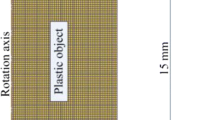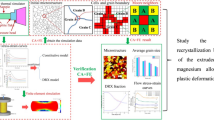Abstract
In this work, the kinetics of recovery and recrystallization as well as microstructural changes after hot deformation of 5083 aluminum alloy were predicted using cellular automata. A neural network modeling was first developed to assess flow stress behavior of the alloy during hot deformation. Afterwards, the kinetics of static recovery was evaluated by means of dislocation theory and a first-order differential equation while the results of the neural network model were taken as the initial condition. Moreover, at high temperature i.e., 300 °C or higher, the occurrence of static recrystallization was also simulated employing two-dimensional cellular automata. To assess physical parameters, validation of the model and construction of the neural network, single-hit and double-hit tensile tests together with microstructural evolutions were conducted at temperatures ranging between 180 and 380 °C. Comparing the real and simulated microstructures showed a good consistency indicating that the modeling was working properly. The model is capable of considering the impact of different parameters such as the initial grain size, the pre-strain and holding time on the rate of softening and the final microstructures. The results showed that static recovery was the main softening process at temperatures 180–260 °C, however, the rate of static recovery was slightly reduced at 260 °C owing to the occurrence of dynamic recovery during hot deformation. On the other hand, static recrystallization became the dominant softening mechanism at 300 °C or higher temperatures and the activation energies for nucleation and growth processes during recrystallization were computed as 141 kJ/mole and 153 kJ/mole.













Similar content being viewed by others
Data availability
The authors declare that all experimental and simulation data supporting the results of this work are presented in the article.
References
Asgharzadeh A, Jamshidi Aval H, Serajzadeh S (2016) A study on flow behavior of AA5086 over a wide range of temperatures. J Mater Eng Perform 25:1076–1084
Churyumova AY, Mikhaylovskayaa AV, Bazlova AI, Tsarkova AA, Kotova AD, Aksenov SA (2017) Influence of Al3Ni crystallisation origin particles on hotdeformation behaviour of aluminium based alloys. Philos Mag. https://doi.org/10.1080/14786435.2016.1273557
Davies C, Hong L (1999) The cellular automaton simulation of static recrystallization in cold-rolled AA1050. Scripta Mater 40:1145–1152
Fan XH, Li M, Li DY, Shao YC, Zhang SR, Peng YH (2014) Dynamic recrystallisation and dynamicprecipitation in AA6061 aluminium alloyduring hot deformation. Mater Sci Technol 30:1263–1272
Golden RM (1996) Mathematical methods for neural network analysis and design. MIT Press
Gutierrez I, Castro FR, Urcola JJ, Fuentes M (1988) Static recrystallization kinetics of commercial purity aluminium after hot deformation within the steady state regime. Mater Sci Eng A 102:77–84
Han F, Tang B, Kou H, Li J, Feng Y (2013) Cellular automata modeling of static recrystallization based on the curvature driven subgrain growth mechanism. J Mater Sci 48:7142–7152
Hoffman JE (2001) Numerical methods for engineers and scientists, 2en edn. Marcel Dekker Inc, New York
Hsiao S, Chang C, Tseng T, Kuo J (2023) Cellular automaton-based modeling of recrystallization texture considering instability criterion and nonuniform boundary mobility in AA1100 Aluminum Alloy. Adv Eng Mater. https://doi.org/10.1002/adem.202201687
Humphreys FJ, Hatherly M (2004) Recrystallization and related annealing phenomena. Pergamon Press, New York
Jiang F, Zurob HS, Purdy GR, Zhang H (2015) Static softening following multistage hot deformation of 7150 aluminum alloy. Exp Model 648:164–177
Kassner ME, McQueen HJ, Evangelista E (1993) Geometric dynamic recrystallization in aluminium and aluminium alloys above 06Tm. Mater Sci Forum 113–115:151–156
Kazantzis AV, Chen ZG, De Hosson JThM (2013) Deformation mechanism of aluminum–magnesium alloys at elevated temperatures. J Mater Sci 48:7399–7408
Khamei AA, Dehghani K (2015) Effects of strain rate and temperature on hot tensile deformation of severe plastic deformed 6061 aluminum alloy. Mater Sci Eng, A 627:1–9
Kremeyer K (1998) Cellular automata investigations of binary solidification. J Comput Phys 142:243–262
Lin YC, Zhang J, Zhong J (2008) Application of neural networks to predict the elevated temperature flow behavior of a low alloy steel. Comput Mater Sci 43:752–758
Lin YC, Li L, Fu Y, Jiang YQ (2012) Hot compressive deformation behavior of 7075 Al alloy under elevated temperature. J Mater Sci 47:1306–1318
Lin YC, Liu Y, Chen M, Huang M, Ma X, Long Z (2016) Study of static recrystallization behavior in hot deformed Ni-based superalloy using cellular automaton model. Mater Des 99:107–114
Liu J (2013) Radial basis function (RBF) neural network control for mechanical systems: design, analysis and MATLAB simulation. Springer-Verlag, Berlin
Lyttle MT, Wert JA (1994) Modelling of continuous recrystallization in aluminium alloys. J Mater Sci 29:3342–3350
Mirzadeh H (2015) Constitutive description of 7075 aluminum alloy during hot deformation by apparent and physically-based approaches. J Mater Eng Perform 24:1095–1099
Mortazavi SNS, Serajzadeh S (2019) Simulation of non-isothermal recrystallization kinetics in cold-rolled steel. Multiscale Multidiscip Model Exp Design 2:23–33
Navid Moghadam N, Serajzadeh S (2023) Warm and hot deformation behaviors and hot workability of an Aluminum-Magnesium alloy using artificial neural network. Mater Today Commun. https://doi.org/10.1016/j.mtcomm.2023.105986
Nes E (1995) Recovery revisited. Acta Metall Mater 43:2189–2207
Park SY, Kim WJ (2016) Difference in the hot compressive behavior and processing maps between the As-cast and Homogenized Al-Zn-Mg-Cu (7075) Alloys. J Mater Sci Technol 32:660–670. https://doi.org/10.1016/j.jmst.2016.04.006
Raja N, Daniel BSS (2019) Physical simulation and processing map of aluminum 7068 Alloy. Mater Perform Charact. https://doi.org/10.1520/MPC20190018
Raja N, Daniel BSS (2022) Microstructural evolution of Al-7.3Zn-2.2Mg-2Cu (Al7068) alloy in T6 condition during isothermal compression using 3-dimensional processing map. J Alloys Comp. https://doi.org/10.1016/j.jallcom.2022.163690
Raja N, Sinha M, Gautam G (2023) Dynamic response and microstructural characterization of Al3Zr/Al composite using 3D processing map. J Mater Eng Perform. https://doi.org/10.1007/s11665-023-08007-z
Read W, Shockley W (1950) Dislocation models of crystal grain boundaries. Phys Rev 78:275
Sakai T, Belyakov A, Kaibyshev R, Miura H, Jonas JJ (2014) Dynamic and post-dynamic recrystallization under hot, cold and severe plastic deformation conditions. Prog Mater Sci 60:130–207
SeyedSalehi M, Serajzadeh S (2010) A neural network model for prediction of static recrystallization kinetics under non-isothermal conditions. Comput Mater Sci 49:773–781
Shen J, Hu L, Sun Y, Wan Z, Feng X, Ning Y (2019) A comparative study on artificial neural network, phenomenological-based constitutive and modified fields-Backofen models to predict flow stress in Ti-4Al- 3V–2Mo-2Fe Alloy. J Mater Eng Perform 28:4302–4315
Shewmon P (1989) Diffusion in solids second edition. The Minerals, Metals & Materials Society, Warrendale
Shi C, Mao W, Chen XG (2013) Evolution of activation energy during hot deformation of AA7150 aluminum alloy. Mater Sci Eng A 571:83–91
Svyetlichnyy DS (2012) Simulation of Microstructure evolution during shape rolling with the use of Frontal cellular automata. ISIJ Int 52:559–568
Verdier M, Brechet Y, Guyot P (1998) Recovery of Al-Mg alloys: flow stress and strain-hardening properties. Acta Metall 47:127–134
Xiao N, Zheng C, Li D, Li Y (2008) Asimulation of dynamic recrystallization by coupling a cellular automaton method with a topology deformation technique. Comput Mater Sci 41:366–374
Yang QY, Yang D, Zhang Z, Cao L, Wu X, Huang G, Liu Q (2016) Flow behavior and microstructure evolution of 6A82 aluminium alloy with high copper content during hot compression deformation at elevated temperatures. Trans Nonferrous Met Soc China 26:649–657
Zhang H, Lin GY, Peng DS, Yang LB, Lin QQ (2004) Dynamic and static softening behaviors of aluminum alloys during multistage hot deformation. J Mater Process Technol 148:245–249
Zhang T, Lu S, Zhang J, Li Z, Chen P, Gong H, Wu Y (2017) Modeling of the static recrystallization for 7055 aluminum alloy by cellular automaton. Modell Simul Mater Sci Eng 25:065005
Zhang J, Yi Y, Huang S, Mao X, He H, Tang J, Guo W, Dong F (2021) Dynamic recrystallization mechanisms of 2195 aluminum alloy during medium/high temperature compression deformation. Mater Sci Eng A 804:140650. https://doi.org/10.1016/j.msea.2020.140650
Funding
This work has not received specific support from any funding agencies in the public, commercial, or not-for-profit sectors.
Author information
Authors and Affiliations
Contributions
Both Authors wrote the main manuscript and the second author reviewed and revised the manusscript.
Corresponding author
Ethics declarations
Conflict of interest
The authors declare that they have no conflict of interest.
Additional information
Publisher's Note
Springer Nature remains neutral with regard to jurisdictional claims in published maps and institutional affiliations.
Rights and permissions
Springer Nature or its licensor (e.g. a society or other partner) holds exclusive rights to this article under a publishing agreement with the author(s) or other rightsholder(s); author self-archiving of the accepted manuscript version of this article is solely governed by the terms of such publishing agreement and applicable law.
About this article
Cite this article
Mirdar, M., Serajzadeh, S. Simulation of microstructural changes after hot deformation of aluminum–magnesium alloy using cellular automata. Multiscale and Multidiscip. Model. Exp. and Des. 6, 505–518 (2023). https://doi.org/10.1007/s41939-023-00159-8
Received:
Accepted:
Published:
Issue Date:
DOI: https://doi.org/10.1007/s41939-023-00159-8




